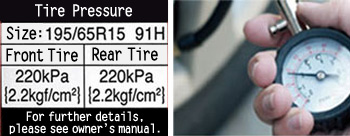1. Regular Rotations
Regular rotations make your tires drive longer, and save you time and money in the long run. During a tire rotation, each tire and wheel is removed from your vehicle and moved to a different position. This ensures that all of the tires wear evenly and last longer. If no period is specified in your owner's manual, the tires should be rotated about every 10,000 km.

2. Checking Tire Pressure
Tire pressure, including the spare tire, should be checked at least once a month or before driving long distance. The pressure should be checked after the tire cools down (at least 3 hours after stopping). Use a tire pressure gauge to check the tire pressure.

The recommended tire pressure for each vehicle is set by the car manufacturer and can be found in various areas of the vehicle such as: car owner’s manual, driver’s side door, and fuel filler door.

Proper tire pressure helps maintain normal fuel consumption and tire wear, optimizes tire life and performance, and effectively improves safety.

3. Safe Driving Habits
Take good care of your driving, for better safety and longer tire life!
- Do not speed. High speeds will generate excessive heat, which increases the rate of tire wear.
- Avoid fast turns on curves and corners.
- Avoid quick starts and panic stops.
- Do not ride on the edge of the pavement or drive over curbs, potholes, or other obstructions.
4. Stay Balanced
Tire balancing and wheel allignment are important for long tire life. Without good balancing, the wheel may shake and uneven tread wear may occur. When you get a check-up for your car, you may also want to check if balancing would help. Benefits of Balancing:

- Prevents tire vibration and tire shimmy
- Does not affect comfort level
- Avoid irregular tire wear
- Avoid irregular vehicle suspension system wear
5. Lighten Your Load
A vehicle consumes about 700 liters of gasoline each year. Each additional 45 kg of goods increases fuel consumption by 1 liter. When possible, avoid carrying unnecessary items, as extra loads put more strain on the vehicle. This leads to higher fuel consumption, as well as decreased tire life.
6. Overall Car Maintainance
Other things in a car also have an effect on tire life. Regular maintenance and tune-ups are one of the best ways to improve fuel economy and vehicle performance. Recommended maintenance schedule can be found in the owner’s manual. Dragging brakes, dirty oil filters, worn spark plugs, low transmission fluid, or transmission going into high gear can all reduce fuel efficiency.
7. Keep Alert for Issues
Every tire has a Tread Wear Indicator (TWI), which form a triangle TWI located on the sidewall. TWI is an indicator of tire wear and is also a benchmark to you to check if your tire is worn out. Tires should be changed immediately when the tire tread has surpassed the indicators.
Worn out tires compromises handling and braking distance tremendously.
Also keep a lookout for physical signs stated below, even if the tires have not worn out yet:
- Tires seem underinflated: A sign of potential air leak or other issue, bring to your local maintenance shop to check
- Bulges on tires: We recommend you to replace the tires immediately, due to high potential of tires bursting
- Cracks on tires: Will show on the tire`s sidewall, this is a sign of replacement needed
8. Cracks on tires: Will show on the tire`s sidewall, this is a sign of replacement needed
Your Runway tires are designed to keep in top shape for a long while, but there will come a time when any tire needs to be replaced. Use a tread measuring tool to determine when the tire tread is worn too thin to continue driving safely. When in doubt, ask your local service center to check for you. When replacing tires, it is best to replace all four, and the brand should be the same for all